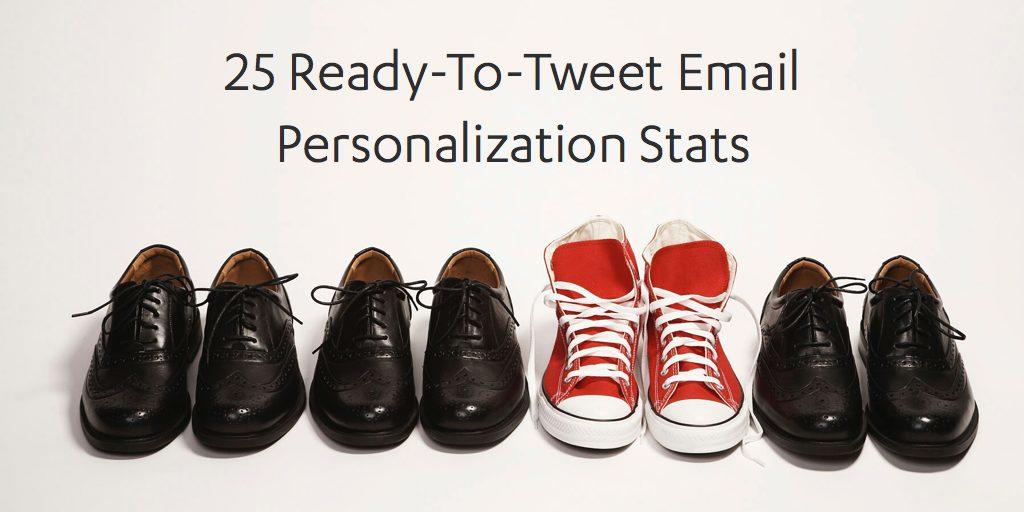May 15, 2015
Email Marketing Statistics
Personalization is tailoring your marketing and content to the individual needs of every person based on their demographics, behavior, and engagement. Generalized one-size-fits-all messaging is not as effective or profitable in comparison. You may already feel the importance of personalization in your gut, but this list of 25 statistics (and their sources) will help bring rock solid data to push you over the edge. The stats will also give you a bigger picture overview of the current trends in content and email personalization. Read on to learn key data points on the importance, barriers, demand, and results of using personalization in your marketing.
How important is personalization to marketers?
- 94% of customer insights and marketing professionals across multiple industries said personalization is “important,” “very important,” or “extremely important.” Source: Conversant, “The Personalization Imperative” (2014)
- 75% of survey respondents plan to increase investment in some or all personalization capabilities. Source: Conversant, “The Personalization Imperative” (2014)
- 46% of the most effective B2C content marketers tailor content to the profile of the decision maker. Source: Content Marketing Institute and MarketingProfs, “B2C Content Marketing: Benchmarks, Budgets, and Trends - North America” (2013)
- Improved business performance and customer experience are the main drivers for personalizing the website experience.
 Source: Econsultancy and Monetate, “The Realities of Online Personalisation” (2013)
Source: Econsultancy and Monetate, “The Realities of Online Personalisation” (2013) - One-third of marketers said “personalization” when asked to prioritize one capability that will be important to the future of their marketing. Source: Adobe, “Digital Roadblock: Marketers Struggle to Reinvent Themselves (2014)
- 94% of businesses say personalization is critical to current and future success. Source: Econsultancy and Monetate, “The Realities of Online Personalisation” (2013)
- 66% of marketers reported that enhanced targeting and personalization were top benefits of marketing automation. Source: “State of Marketing Automation” (2014) The Bottom Line: Across all industries, marketers are grasping the importance of implementing personalization in their business. The felt need is growing, but marketers are still coming up against barriers to implementation.
What are the barriers to personalization?
- The biggest challenges with personalization are gaining insight quickly enough, having enough data, and inaccurate data. Source: Experian Data Quality study (2014)
- Almost a half of companies say that IT roadblocks (47%) and legacy technology (46%) are “major barriers” in their personalization efforts.
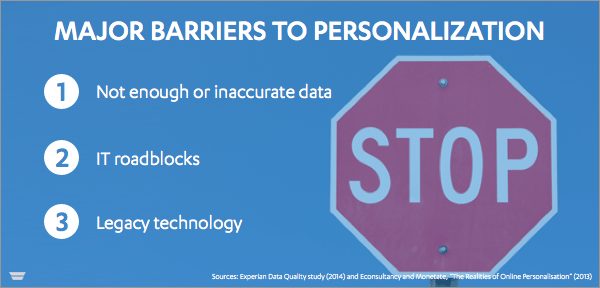 Source: Econsultancy and Monetate, “The Realities of Online Personalisation” (2013)
Source: Econsultancy and Monetate, “The Realities of Online Personalisation” (2013) - 70% of brands fail to personalize their messages. Source: Experian Marketing Services Email Marketing Study (2013) The Bottom Line: Bad data and technology bottlenecks are hindering marketers to making personalization a reality in their business. In the future, legacy technologies will need to catch up or be eclipsed by new data-driven technologies making personalization accessible to marketers.
Do consumers even want personalized content?
- 74% of consumers get frustrated when they receive content that has nothing to do with their interests. Source: Janrain Online Personal Experience study (2013)
- 25% of online consumers would be willing to give up chocolate for a month to receive appropriate content based on their personal interests on all their favorite websites.
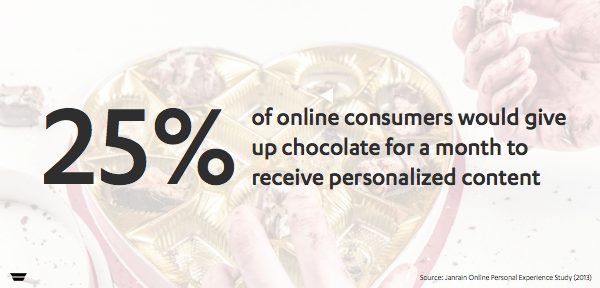 Source: Janrain Online Personal Experience study (2013)
Source: Janrain Online Personal Experience study (2013) - 86% of shoppers who have experienced personalization believe it influences what they purchase to some extent. Source: Digital Capital Advisors, “Marketing Technology Sector Update: Marketing Automation” (2015)
- The top reasons email users unsubscribe from a business or non-profit email subscription are too many emails (69%) and content that is no longer relevant (56%).
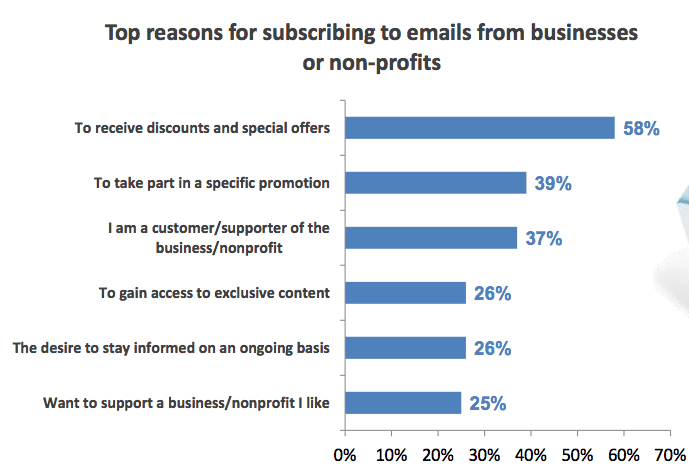 Source: Chadwick Martin Bailey, “10 Facts About Why and How Consumers Like and Subscribe” (2011)
Source: Chadwick Martin Bailey, “10 Facts About Why and How Consumers Like and Subscribe” (2011) - 78% of surveyed consumers said they want some degree of personalization, with 62% preferring a mix of algorithmic and curated content. Source: Yahoo! “The Balancing Act: Getting Personalization Right” (2014) The Bottom Line: Consumers are craving and beginning to expect personalized content from companies. With major brands like Netflix and Amazon taking the lead, personalization is becoming the new normal to consumers.
Does personalization get results?
- Personalized emails deliver six times higher transaction rates than non-personalized emails. Source: Experian Marketing Services Email Marketing Study (2013)
- Relevant emails drive 18x more revenue than broadcast emails.
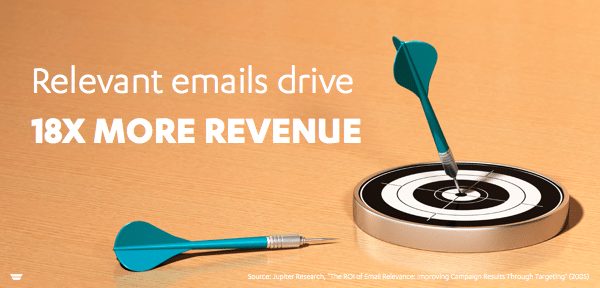 Source: Jupiter Research, “The ROI of Email Relevance: Improving Campaign Results Through Targeting” (2005)
Source: Jupiter Research, “The ROI of Email Relevance: Improving Campaign Results Through Targeting” (2005) - Leads who are nurtured with personalized content produce a 20% increase in sales opportunities. Source: DemandGen Report
- Personalized subject lines deliver 26% higher unique open rates overall. Source: Experian Marketing Services Email Marketing Study (2013)
- 35% of Amazon’s consumer purchases come from their personalized recommendations. Source: McKinsey & Company, “How Retailers Can Keep Up with Consumers” (2013)
- 75% of what Netflix viewers watch comes from their algorithm recommendations. Source: McKinsey & Company, “How Retailers Can Keep Up with Consumers” (2013)
- Personalized emails improve click-through rates by 14%, and conversion rates by 10%.
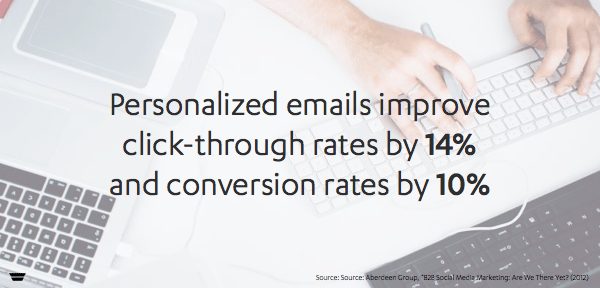 Source: Aberdeen Group, “B2B Social Media Marketing: Are We There Yet? (2012)
Source: Aberdeen Group, “B2B Social Media Marketing: Are We There Yet? (2012) - Personalized promotional mailings had 29% higher unique open rates and 41% higher unique click rates. Source: Experian Marketing Services Email Marketing Study (2013)
- 54% of retailers reported recommendation engines as the key driver of average order value in customer purchases. Source: Forrester and Shop.org, “State of Retailing Online” report (2011)
- Segmentation, personalized salutations, product or service recommendations, and the inclusion of custom database fields in email copy drive 360% higher conversion than a generic email message with a personalized salutation. Source: Gleanster, “5 Key Milestones for the First 30 Days with Marketing Automation” (2012) The Bottom Line: Personalization drives results for businesses of all sizes. Companies who implement personalization see higher engagement rates, increased revenues, a better overall customer experience. Have you come across any other insightful personalization statistics? Let us know in the comments.



